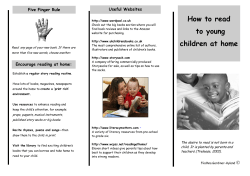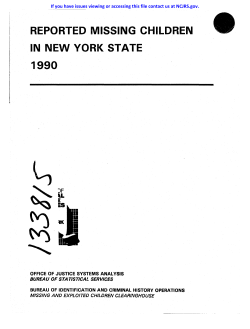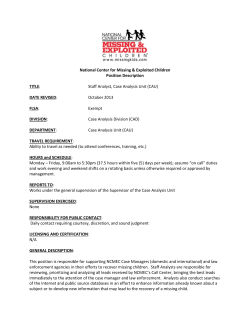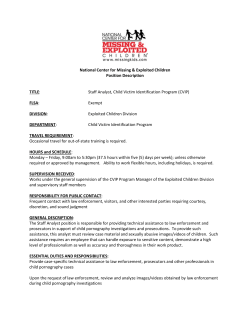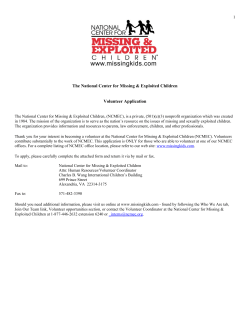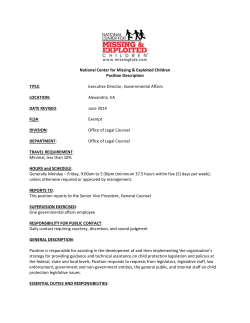
PERSONAL SAFETY FOR CHILDREN A GUIDE FOR PARENTS
PERSONAL SAFETY FOR CHILDREN A GUIDE FOR PARENTS The data on abducted children contained in this report is taken from The Second National Incidence Studies of Missing, Abducted, Runaway, and Thrownaway Children, known as NISMART-2, funded under a grant from the Department of Justice’s Office of Juvenile Justice and Delinquency Prevention. We are grateful to Heather Hammer, Ph.D., Temple University Institute for Survey Research, Principal Investigator of NISMART-2, David Finkelhor, Ph.D., University of New Hampshire, Crimes Against Children Research Center, and Andrea J. Sedlak, Ph.D., and Dana J. Schultz, M.P.P., Westat, Inc., for performing this special analysis. Some materials in this publication have been adapted from the Know the Rules brochure series. Copyright © 1998 National Center for Missing & Exploited Children. All rights reserved. WHAT YOU CAN DO TO PROTECT YOUR CHILD Introduction Children are our Nation’s most precious resource, but as children, they often lack the skills to protect themselves. It is our responsibility, as parents and teachers, to safeguard children and to teach them the skills to be safe. This pamphlet is designed to help you talk to your children about how to protect themselves against abduction and exploitation. It is divided into several sections: WHAT ARE THE RISKS TO YOUR CHILD....................................................................2 facts and figures on child abductions HOW TO TALK TO YOUR CHILD...................................................................................4 tips for discussing child safety WHAT YOU CAN DO TO HELP YOUR CHILD...............................................................6 tips for parents to help their children stay safe WHAT YOUR CHILD CAN DO.......................................................................................8 in general, at home, and at school WHAT TO DO IN AN EMERGENCY ............................................................................12 numbers to call and information to collect ADDITIONAL RESOURCES FOR PARENTS AND CHILDREN ...............................................................inside back cover where to go for more help Every home and school should teach children about safety and protection measures. As a parent, you should take an active interest in your children and listen to them. Teach your children that they can be assertive in order to protect themselves against abduction and exploitation. And most importantly, make your home a place of trust and support that fulfills your child’s needs. Together we can protect our Nation’s children by teaching them to be smart, strong, and safe. 1 WHAT ARE THE RISKS TO YOUR CHILD facts and figures on child abductions Children of every age, gender, and race are vulnerable to child abduction. Non-family Child Abductions by Age Non-family Child Abductions by Gender 0-5 years 7% 15-17 years 59% 12% 6-11 years 22% 12-14 years Male Female 65% 35% Approximately 203,900 children were abducted in 1999 in “family abductions” in which a family member was trying to deprive a caretaker of custodial rights. – 98% of these children were located or returned home. – None of these children were killed. There were approximately 58,200 “non-family abductions” in 1999. Abductions in this category involved forcibly moving or detaining the child for a relatively short period of time, usually in connection with another crime. – 99% of these children returned home. – Only 115 of these were the most serious and dangerous types of abductions — those perpetrated by strangers where the child was kept overnight, held for ransom, or killed. – Almost 60% of these children were returned safely. 2 When the abductor is unrelated to the child, the abductor is just as likely to be someone known to the child or family as to be a stranger. Identity of Perpetrator in Non-Family Abductions 3% Someone Else Friend 17% 45% Stranger 4% Caretaker or Babysitter 21% 6% Acquaintance 5% Neighbor Authority Person Be Alert: Over 50% of the children kidnapped in non-family abductions were taken from the street, in a vehicle, or from a park or wooded area. Almost 75% of those children kidnapped in family abductions were taken from their own or another’s home or yard. 3 HOW TO TALK TO YOUR CHILD tips for discussing child safety Who? You. A parent is the best person to teach a child about personal safety. What? Effective personal safety skills. Smart Thinking Strong Character Sticking Together When? Now. Age and maturity matter. There is no perfect age when parents should begin teaching children about personal safety. A child’s ability to comprehend and practice safety skills is affected by age, educational, and developmental levels. How? LISTEN to your children. Know your children’s daily activities and habits. Listen to what they like and what they don’t like. Encourage open communication. Let your children know they can talk to you about any situation. Reassure your children that their safety is your #1 concern. 4 TEACH your children. Set boundaries about places they may go, people they may see, and things they may do. Reinforce the importance of the “buddy system.” It’s OK to say NO – tell your children to trust their instincts. Get INVOLVED. Know where your children are at all times. Your children should check in with you if there is a change in plans. There is no substitute for your attention and supervision. PRACTICE safety skills with your child. Rehearse safety skills so that they become second nature. 5 WHAT YOU CAN DO TO HELP YOUR CHILD tips for parents to help their children stay safe Safety at Home Children should know their full name, home phone number and how to use the telephone. Post your contact information where your children will see it: office phone number, cell phone, pager, etc. Children should have a trusted adult to call if they’re scared or have an emergency. Choose babysitters with care. Obtain references from family, friends, and neighbors. Once you have chosen the caregiver, drop in unexpectedly to see how your children are doing. Ask your children how the experience with the caregiver was, and listen carefully to their responses. Safety in the Neighborhood Make a list with your children of their neighborhood boundaries, choosing significant landmarks. Interact regularly with your neighbors. Tell your children whose homes they are allowed to visit. Don’t drop your children off alone at malls, movie theatres, video arcades, or parks. Teach your children that adults should not approach children for help or directions. Tell your children that if they are approached by an adult, they should stay alert because this may be a “trick.” Never leave children unattended in an automobile. Children should never hitchhike or approach a car when they don’t know and trust the driver. 6 Children should never go anywhere with anyone without getting your permission first. Safety at School Be careful when you put your child’s name on clothing, backpacks, lunch boxes or bicycle license plates. If a child’s name is visible, it may put them on a “first name” basis with an abductor. Walk the route to and from school with your children, pointing out landmarks and safe places to go if they’re being followed or need help. Make a map with your children showing acceptable routes to school, using main roads and avoiding shortcuts or isolated areas. If your children take a bus, visit the bus stop with them and make sure they know which bus to take. 7 WHAT YOUR CHILD CAN DO the rules for younger children I KNOW my name, address, telephone number, and my parents’ names. I always CHECK FIRST with my parents or the person in charge. I tell them before I go anywhere or get into a car, even with someone I know. I always CHECK FIRST with my parents or a trusted adult before I accept anything from anyone, even from someone I know. I always TAKE A FRIEND with me when I go places or play outside. I SAY NO if someone tries to touch me or treat me in a way that makes me feel scared, uncomfortable, or confused. It’s OK to SAY NO, and I KNOW that there will always be someone who can help me. I KNOW that I can TELL my parents or a trusted adult if I feel scared, uncomfortable, or confused. STRONG, SMART, and have the right to be SAFE. I am 8 WHAT YOUR TEEN CAN DO the rules for older children DON’T GO OUT ALONE. There is safety in numbers. This rule isn’t just for little kids, it applies to teens, too. ALWAYS TELL AN ADULT WHERE YOU’RE GOING. Letting someone know where you’ll be at all times is smart. If you’re faced with a risky situation or get into trouble, your family and friends will know where to find you. SAY NO IF YOU FEEL THREATENED. If someone — anyone — touches you in a way that makes you feel uncomfortable, you have the right to say no. Whether it is pressure about sex, drugs, or doing something that you know is wrong, be strong and stand your ground. CAUTION. COMMUNICATION. CONFIDENCE. 9 WHAT YOUR CHILD CAN DO at school and at home School Tips: Always TAKE A FRIEND when walking or riding your bike to and from school. Stay with a group while waiting at the bus stop. It’s safer and more fun to be with your friends. If anyone bothers you while going to or from school, get away from that person, and TELL a trusted adult like your parents or teacher. If an adult approaches you for help or directions, remember grownups needing help should not ask children for help; they should ask other adults. If someone you don’t know or feel comfortable with offers you a ride, say NO. If someone follows you, get away from him or her as quickly as you can. Always be sure to TELL your parents or a trusted adult what happened. If someone tries to take you somewhere, quickly get away and yell, “This person is trying to take me away!” or “This person is not my father (mother)!” If you want to change your plans after school, always CHECK FIRST with your parents. Never play in parks, malls, or video arcades by yourself. 10 If you go home alone after school, check to see that everything is okay before you go in. Once inside, call your parents to let them know that you are okay. Make sure you follow your “Home Alone” tips. Trust your feelings. If someone makes you feel scared or uncomfortable, get away as fast as you can and TELL a trusted adult. Home Alone Tips for Teens: Check out the house before entering. Go to a safe place to call for help if something doesn’t seem right. Lock the door. Call your mom or dad when you get home to let them know you’re safe. Never tell callers that your parents aren’t home. Instead say that he or she can’t come to the phone and offer to take a message. Don’t open the door for or talk to anyone who comes to your home unless that person is a trusted family friend or relative and your mom or dad has said it is okay. 11 WHAT TO DO IN AN EMERGENCY numbers to call and information to collect Precautionary Measures: Necessary Materials Keep a complete description of your child. Take color photographs of your child every six months. Keep copies of your child’s fingerprints. Keep a sample of your child’s DNA. Know where your child’s medical records are located. Have your dentist prepare and maintain dental charts for your child. What You Should Do In Case Your Child Is Missing: Immediately report your child missing to your local law enforcement agency. Ask the law enforcement agency to enter your child into the National Crime Information Center (NCIC) Missing Persons File. Limit access to your home until law enforcement arrives and has the opportunity to collect possible evidence. Give law enforcement investigators all information you have on your child including fingerprints, photographs, complete description and the facts and circumstances related to the disappearance. Call NCMEC at 1-800-THE-LOST (1-800-843-5678) 12 ADDITIONAL RESOURCES FOR PARENTS AND CHILDREN where to go for more help In an Emergency or if you have information about a missing or exploited child: Call 911 and notify your local police Call 1-800-THE-LOST (1-800-843-5678 ) To report information about child pornography, child molestation, child prostitution, and the online enticement of children: Log on to NCMEC’s CyberTipline at: www.cybertipline.com The following websites provide additional information about pro tecting children from abduction and exploitation: Office of Juvenile Justice and Delinquency Prevention, Department of Justice OJJDP Publications—Child Protection http://ojjdp.ncjrs.org/pubs/missing.html National Center for Missing and Exploited Children (NCMEC) http://www.missingkids.com NCMEC’s website to teach children about dangers on the Internet http://www.netsmartz.org The Federal Bureau of Investigation’s Crime Against Children Program webpage http://www.fbi.gov/hq/cid/cac/crimesmain.htm The Federal Bureau of Investigation’s Tip and Public Leads webpage https://www.ifccfbi.gov/complaint/terrorist.asp McGruff the Crime Dog Information for child safety, identification, abduction, fingerprinting, and crime prevention http://mcgruff-safe-kids.com/ PERSONAL SAFETY FOR CHILDREN -A GUIDE FOR PARENTS
© Copyright 2025



